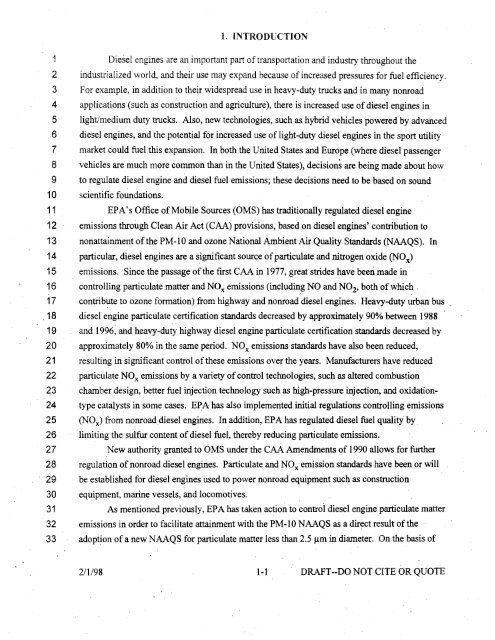Health Assessment Document for Diesel Emissions - NSCEP | US ...
Health Assessment Document for Diesel Emissions - NSCEP | US ...
Health Assessment Document for Diesel Emissions - NSCEP | US ...
You also want an ePaper? Increase the reach of your titles
YUMPU automatically turns print PDFs into web optimized ePapers that Google loves.
l. INTRODUCTION<br />
1 <strong>Diesel</strong> engines are an important part of transportation and industry throughout the<br />
2 industrialized world, and their use may expand because of increased pressures <strong>for</strong> fuel efficiency.<br />
3 For example, in addition to their widespread use in heavy-duty trucks and in many nonroad<br />
4 applications (such as construction and agriculture), there is increased use of diesel engines in<br />
5 light/medium duty trucks. Also, new technologies, such as hybrid vehicles powered by advanced<br />
6 diesel engines, and the potential <strong>for</strong> increased use of light-duty diesel engines in the sport utility<br />
7 market could fuel this expansion. In both the United States and Europe (where diesel passenger<br />
8 vehicles are much more common than in the United States), decisions are being made about how<br />
9 . to regulate diesel engine and diesel fuel emissions; these decisions need to be based oil sound<br />
1 0 scientific foundations.<br />
11 EPA's Office of Mobile Sources (OMS) has traditionally regulated diesel engine<br />
12 emissions through Clean Air Act (CAA) provisions, based on diesel engines' contribution to<br />
13 nonattainment ofthe PM-10 and ozone National Ambient-Air Quality Standards (NAAQS). In<br />
14 particular, diesel engines are a significant source of particulate and nitrogen oxide (NOx).<br />
15 emissions. Since the passage of the first CAA in 1977, great strides have beeri made in·<br />
16 controlling particulate matter and NOx emissions (including NO and N0 2 , both of which .<br />
17 contribute to ozone <strong>for</strong>mation) from highway and nonroad diesel engines. Heavy-duty urban bus<br />
18 diesel engine particulate certification standards decreased by approximately 90% between 1988<br />
19 and 1996, and heavy-duty highway diesel engine particulate certification standards decreased by<br />
20 approximately 80% in the same period. NOx emissions standards have also been reduced,<br />
21 resulting in significant control of these emissions over the years. Manufacturers have reduced<br />
22 particulate NOx emissions by a variety of control technologies, such as altered combustion<br />
23 chamber design, better fuel injection technology such as high-pressure injection, and oxidation-<br />
24 type catalysts in some cases. EPA has also implemented initial regulations controlling emissions<br />
25 (NOx) from nonroaddiesel engines. In addition, EPA has regulated diesel fuel qualitY by<br />
26 limiting the sulfur content of diesel fuel, thereby reducing particulate emissions.<br />
27 New authority granted to OMS under the CAA Amendments of 1990 allows <strong>for</strong> further<br />
28 regulation of nonroad diesel engines. Particulate and NOx emission standards have been or will<br />
29 be established <strong>for</strong> diesel engines used to power nonroad equipment such as construction<br />
30 equipment, marine vessels, and locomotives.<br />
31 As mentioned previously, EPA has taken action to control diesel engineparticulate matter<br />
32 emissions in order to facilitate attainment with the PM-10 NAAQS as a direct result ofthe<br />
33 adoption of a new NAAQS <strong>for</strong> particulate matter less than 2.5 J.lm in diameter. On the basis of<br />
211/98 1-1 DRAFT--DO NOT CITE OR QUOTE















